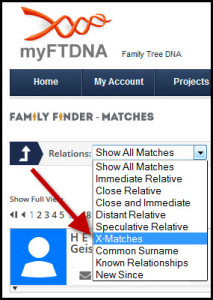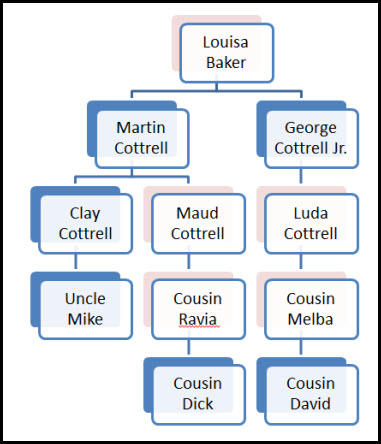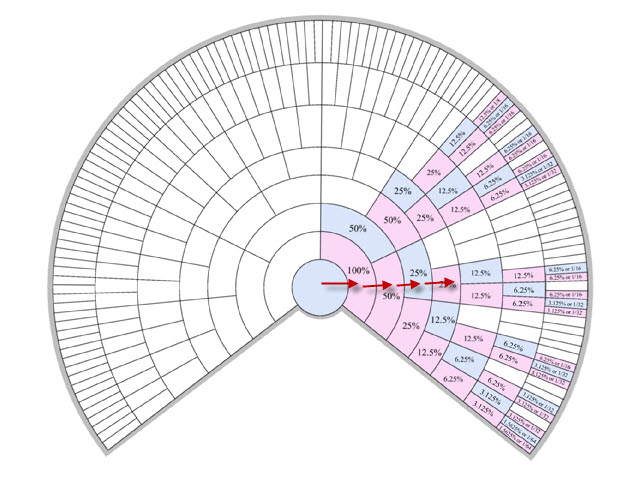New tool at FTDNA
So there’s a brand-new tool at Family Tree DNA this week to help with our autosomal DNA analysis.
 And boy is it going to take some getting used to…
And boy is it going to take some getting used to…
What we were handed was a way of directly comparing one person’s X-DNA against another person’s X-DNA.
Now let’s stop for a second and define terms.
Autosomal DNA is a kind of DNA we all have, contained within our autosomes. All of us as human beings have 23 pairs of chromosomes, with one chromosome in each pair inherited from our mothers and the other one from our fathers. All but one of these pairs are referred to with numbers — chromosomes 1 through 22 to be precise. And the autosomes are all of our numbered chromosomes.1
Because autosomes are inherited equally from both parents, autosomal DNA testing is the type that can be done by men or women. It helps us find cousins in fairly recent generations. But when we inherit those autosomes, we get them jumbled up — what we get from each parent is a purely random mix of the autosomal DNA from their parents, which is a purely random mix of the autosomal DNA from their parents, and so on.2
And that random mixing, called recombination, means that in just a few generations, the amount of DNA we might have in common with a cousin may well be too small to show up as a match.3
That’s very different from Y-DNA, the kind of DNA contained in the gender-determinative Y chromosome that men have — it’s passed down from father to son to son with very few changes over the generations.4 It’s also very different from mitochondrial DNA, the kind of DNA we all receive from our mothers and that’s passed down through the female line — only daughters can pass it on to their children.5
So where does this new tool fit in? Well, it’s the other side of that last chromosome pair — the one without the numbers. That last pair determines our sex. Women have two X chromosomes, one from our fathers and one from our mothers. Men have one X from their mothers and one Y from their fathers. (In case you didn’t notice, it’s that pesky Y chromosome that makes the guys guys.)6
And this X-DNA stuff doesn’t work exactly like any of the other DNA types at all.
A man gets only one X chromosome, from his mother, so his X-DNA is only from his mother’s side of the family. There’s nothing inherited in the X-DNA from his father’s side at all. But when a mother passes on that X, she gives her child a random mix of the X-DNA she got from her mother and her father. So two brothers will each receive only one X chromosome, each from their mother, but because of the random mixing their X-DNA will not be exactly the same. Here for example is a comparison of the X-DNA of two of my mother’s brothers:

A woman gets two X chromosomes, one from her mother that’s the same type of random mix that her brother got (meaning she won’t match her brother exactly on that chromosome either) — and one from her father. And since her father doesn’t have another X chromosome for his X to recombine with when he passes it on, what he gives to his daughter is exactly the same X he got from his mother. And that’s where the random mixing took place: at his mother’s level.
So brothers and sisters will show very different X-DNA results, as this comparison of one uncle’s X-DNA to his brother (in orange) and his sisters (in blue and green):

And what that means is that the whole pattern is different from other DNA types: who we inherited the X-DNA from and how it’s randomly mixed. Which affects who we match.
 Sounds confusing, right? That’s why we need charts, and thank heavens for the genetic genealogists out there who’ve done them. My recommendations: The Genetic Genealogist Blaine Bettinger’s charts accompanying his posts “Unlocking the Genealogical Secrets of the X Chromosome” and “More X-Chromosome Charts” and Debbie Parker Wayne’s charts at
Sounds confusing, right? That’s why we need charts, and thank heavens for the genetic genealogists out there who’ve done them. My recommendations: The Genetic Genealogist Blaine Bettinger’s charts accompanying his posts “Unlocking the Genealogical Secrets of the X Chromosome” and “More X-Chromosome Charts” and Debbie Parker Wayne’s charts at
“X-DNA Inheritance Charts.” Read the accompanying posts for more help understanding this DNA type too!
Let’s look at an example. [Updated, thanks to a reader comment:] My cousin Dick and my cousin David are both related in the same line to my Uncle Mike. The chart here to the left defines the relationship: all descend from the union of Martha Louisa Baker and my nemesis second great grandfather George Washington Cottrell. Mike and Dick both descend from the oldest son, Martin, and David from the youngest son, George Jr.
All three men show up as autosomal matches to each other. Dick and David are third cousins to each other, Dick is a first cousin once removed and David a second cousin once removed to Mike.
But Dick and David do not show up as X-DNA matches to Mike at all.
Can you see why?
It’s because, for a man, the X-DNA match has to start with the mother — it’s her X-DNA they inherit. And Dick and David are cousins on Mike’s father’s side.
But Dick and David do show up as X-DNA matches to each other: by luck, the inheritance path works out. Follow the arrows in the chart below (from Blaine Bettinger’s posts) from each man to his mother, from the mother to the maternal grandmother, from the maternal grandmother to her father the maternal great grandfather and from that great grandfather to his mother, the in-common second great grandmother:

Now using these charts and this additional information may help us down the road to figure out where we match someone else — where in our lines the common ancestor could be, and where in our lines the common ancestor can’t be. It’s complicated, and it’s going to take some work, and… and… and…
It’s going to be great fun. One more quiver in our DNA bow… the hunt is on!
SOURCES
- Judy G. Russell, “Term of the day: autosomes,” The Legal Genealogist, posted 20 Oct 2013 (https://www.legalgenealogist.com/blog : accessed 4 Jan 2014). ↩
- Judy G. Russell, “Autosomal DNA testing,” National Genealogical Society Magazine, October-December 2011, 38-43. ↩
- For the rough percentage of DNA in common with cousins at various levels, see the cousin tree chart at the ISOGG wiki. ISOGG Wiki (http://www.isogg.org/wiki), “File:Cousin tree (with genetic kinship).png,” rev. 2 July 2012. ↩
- See ISOGG Wiki (http://www.isogg.org/wiki/Y_chromosome_DNA_test), “Y chromosome DNA test,” rev. 30 October 2013. And see CeCe Moore, “DNA Testing for Genealogy – Getting Started, Part One,” Geni Blog, posted 18 July 2012 (http://www.geni.com/blog/dna-testing-for-genealogy-getting-started-part-one-375984.html : accessed 1 December 2013). ↩
- See ISOGG Wiki (http://www.isogg.org/wiki/Mitochondrial_DNA_tests), “Mitochondrial DNA tests,” rev. 8 November 2013. ↩
- Russell, “Term of the day: autosomes.” ↩



Thanks for the explanation. I was just playing with this last night and found of my 11 X matches (one being my maternal uncle) there was a woman with a chart that listed my matrilineal surname I am trying to prove. Another piece of evidence!
That’s terrific, Elissa!
Fascinating! That means that from 64 of the male’s 7th generation maternal ancestors, he inherits genes from 8 males and 13 females. Ain’t nature tricky!
It really is astounding when you look at it!
As pointed out by others elsewhere, there are Fibonacci numbers here.
Isn’t Dick a FIRST cousin once removed to Uncle Mike. Dick and David do not appear to be “related in exactly the same way” to Uncle Mike.
After we sort this out, I’ll go back and finish the article.
Ah you’re right — I don’t know how I missed that! Thanks for the correction.
Judy,
I want to let you know that your two of your blog posts are listed in today’s Fab Finds post at http://janasgenealogyandfamilyhistory.blogspot.com/2014/01/follow-friday-fab-finds-for-january-10.html
Have a wonderful weekend!
Thanks, Jana, and hope your weekend is terrific too!
I want to know if its wrong to say that women have got 23 pairs of autosomes because the gonosomes of women are homologous since they contain XX chromosomes which are identical
No, it’s not wrong, because although the X chromosomes of women are homologous (meaning “of similar structure”), they are NOT identical, not even inherited from the same parent. A woman receives one more-or-less recombined X chromosome from her mother, containing bits and pieces from her maternal line, and one unrecombined X chromosome from her father, containing bits and pieces from her father’s line. NOT identical.
How much is this test
You receive the X-DNA results as part of an autosomal DNA test. To really be able to use them, you have to be able to see the X results separately, so testing with Family Tree DNA is advisable. The Family Finder test there is currently priced at $79.
I would love for someone to help me figure if someone is related to me on my mothers maternal side or my mothers paternal side. She was adopted and has found some siblings that were also adopted. No news on parents. is this possible to figure out?
It may be possible, depending on what other information is available and how the test results of all of the matches work out. If you need help with this, there are websites and Facebook groups that specialize in assisting adoptees. See the resources in the post Help with DNA for adoptees.